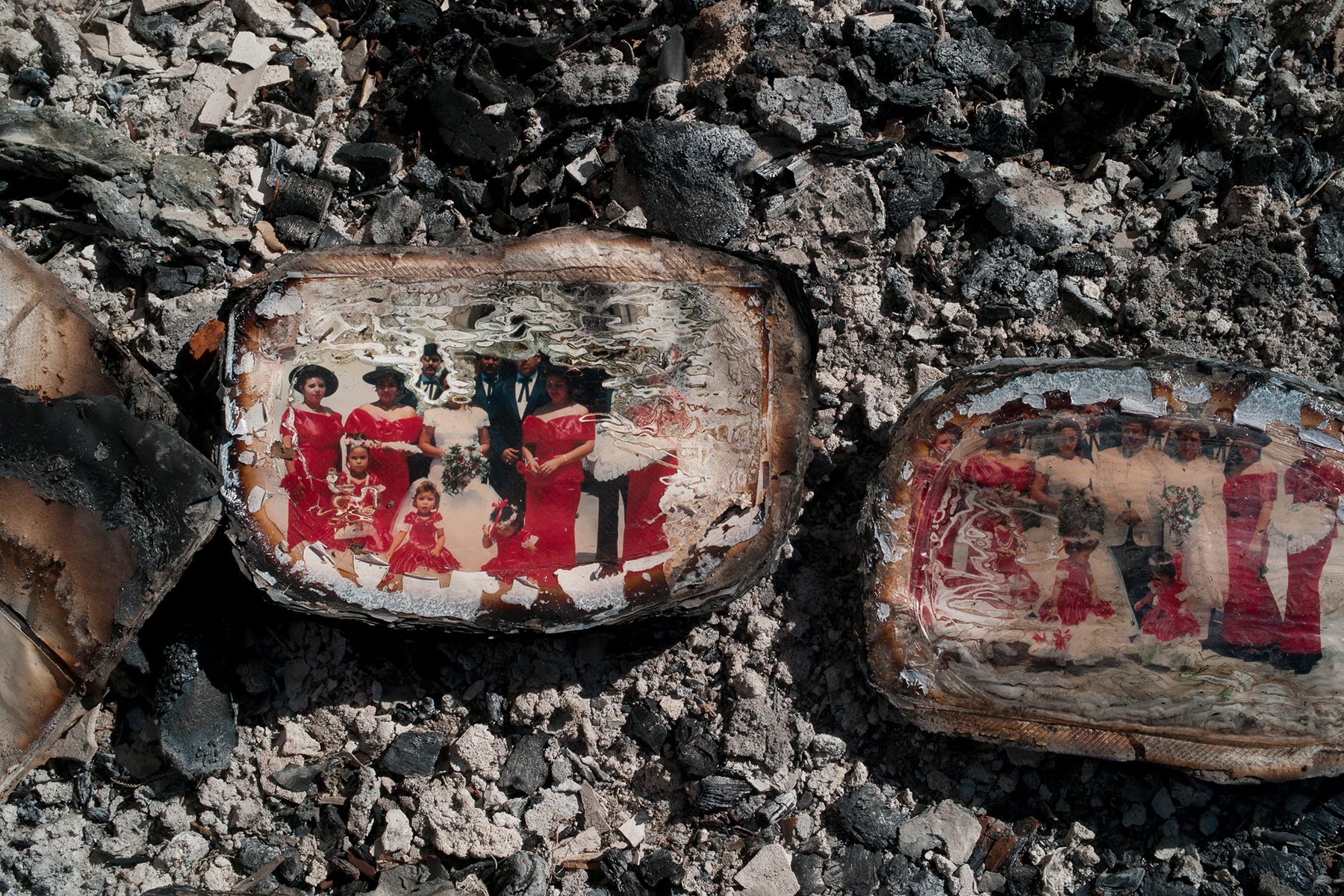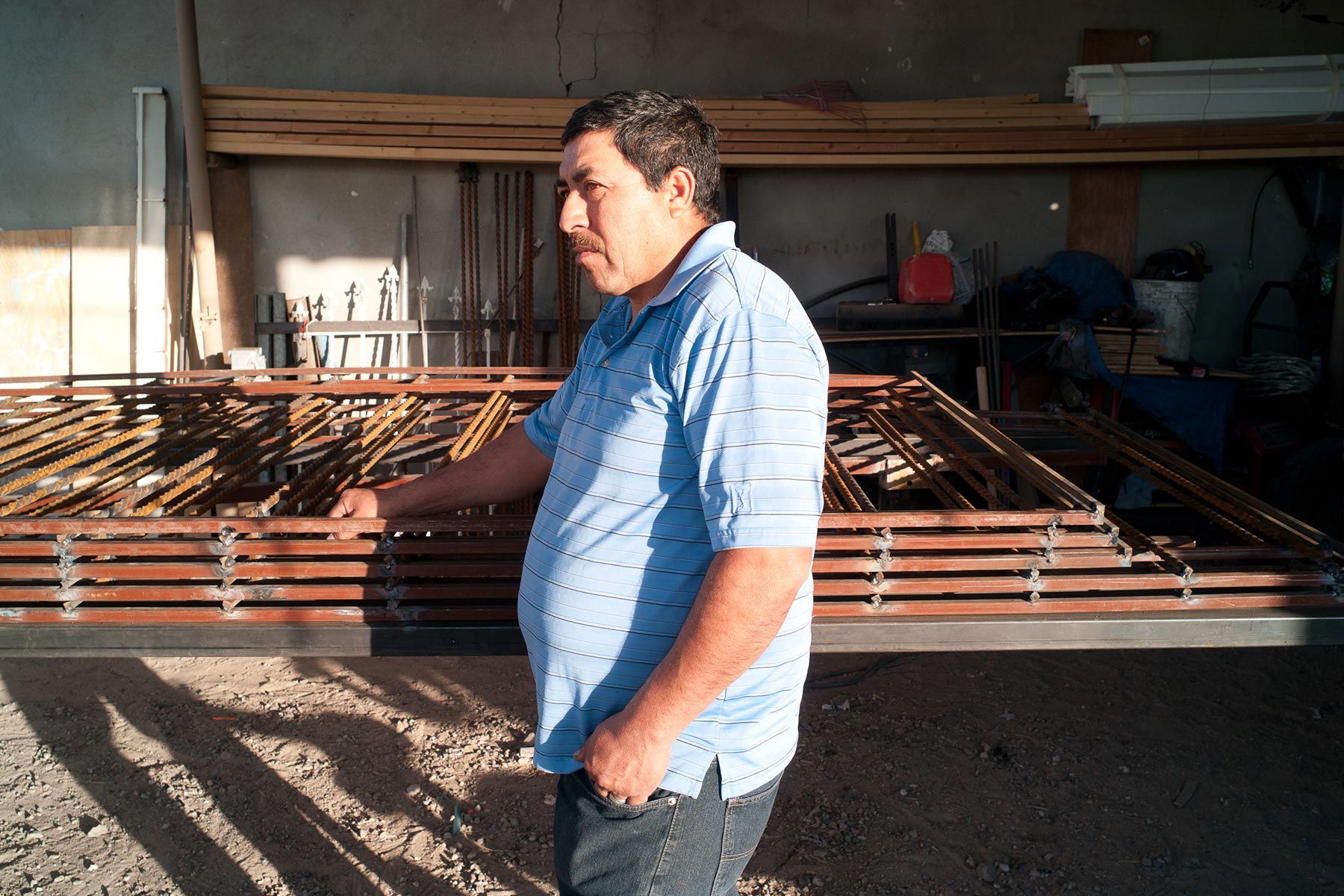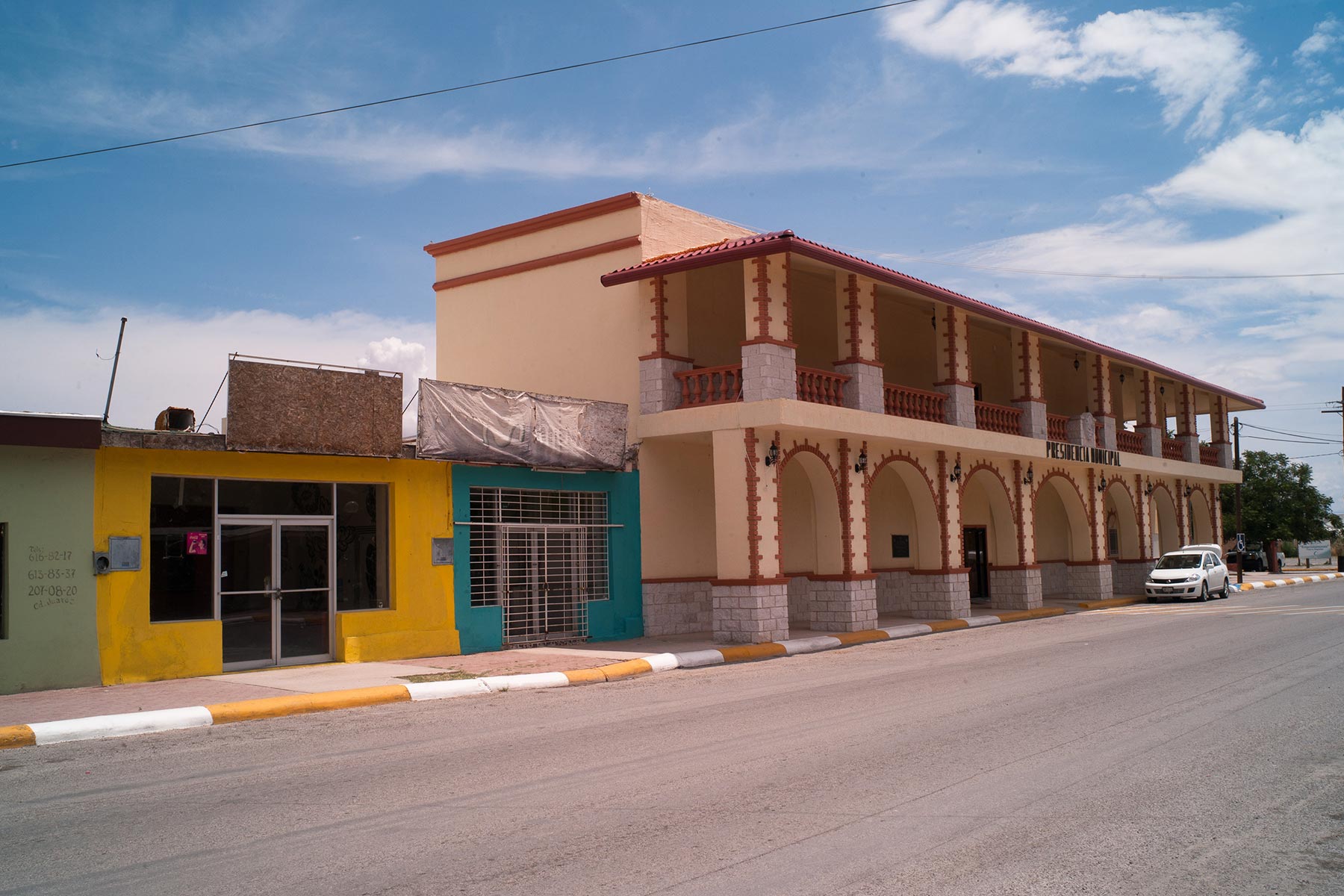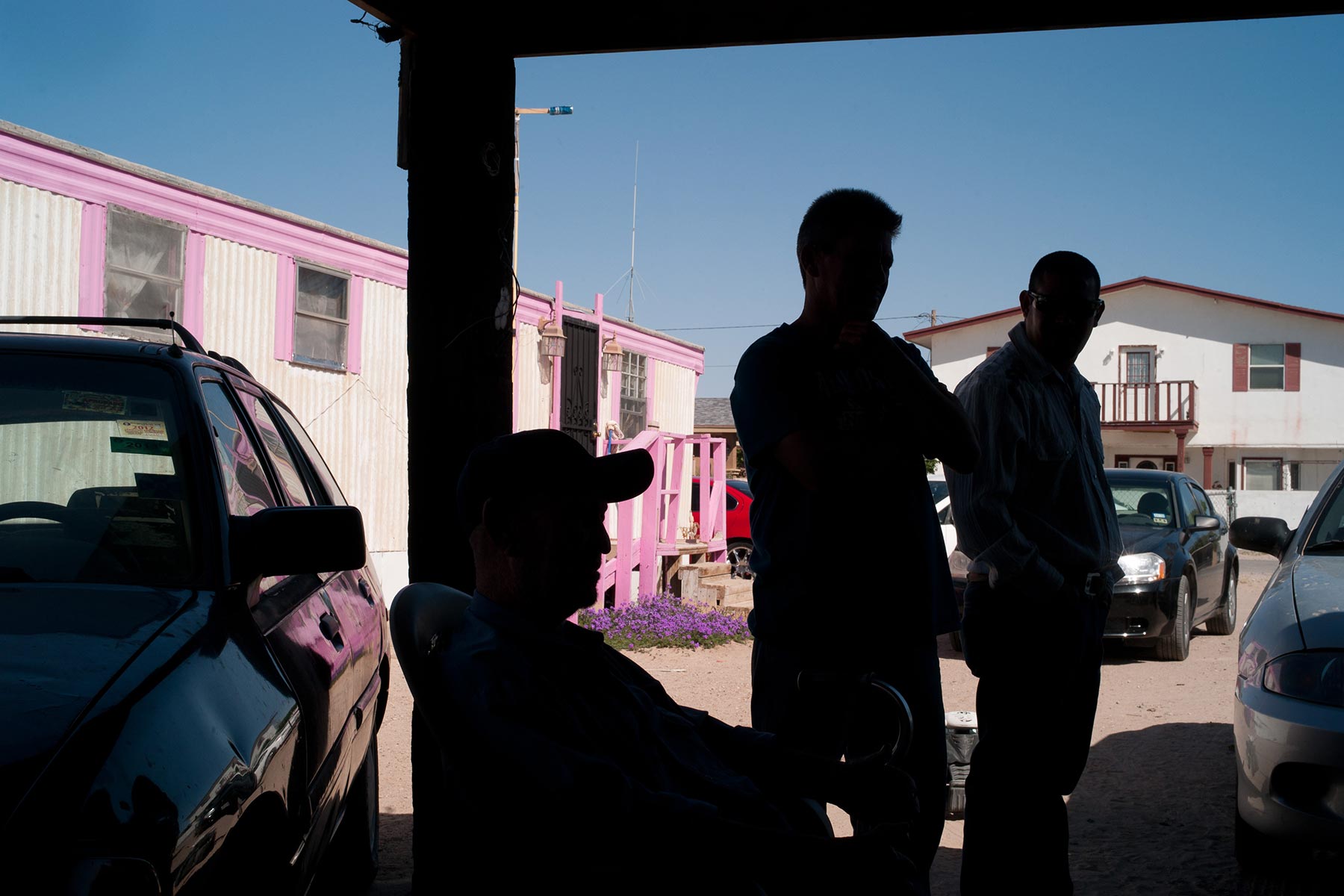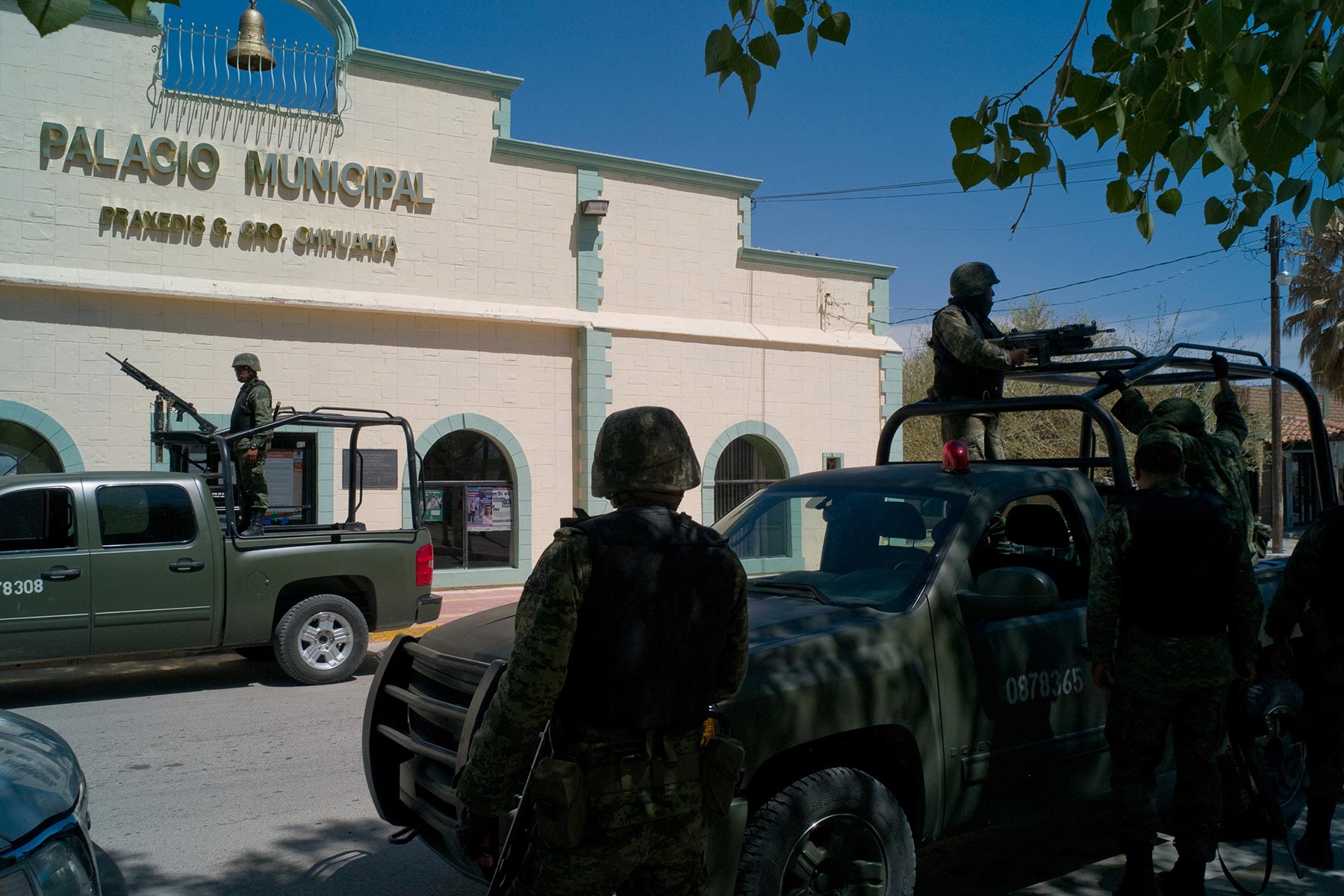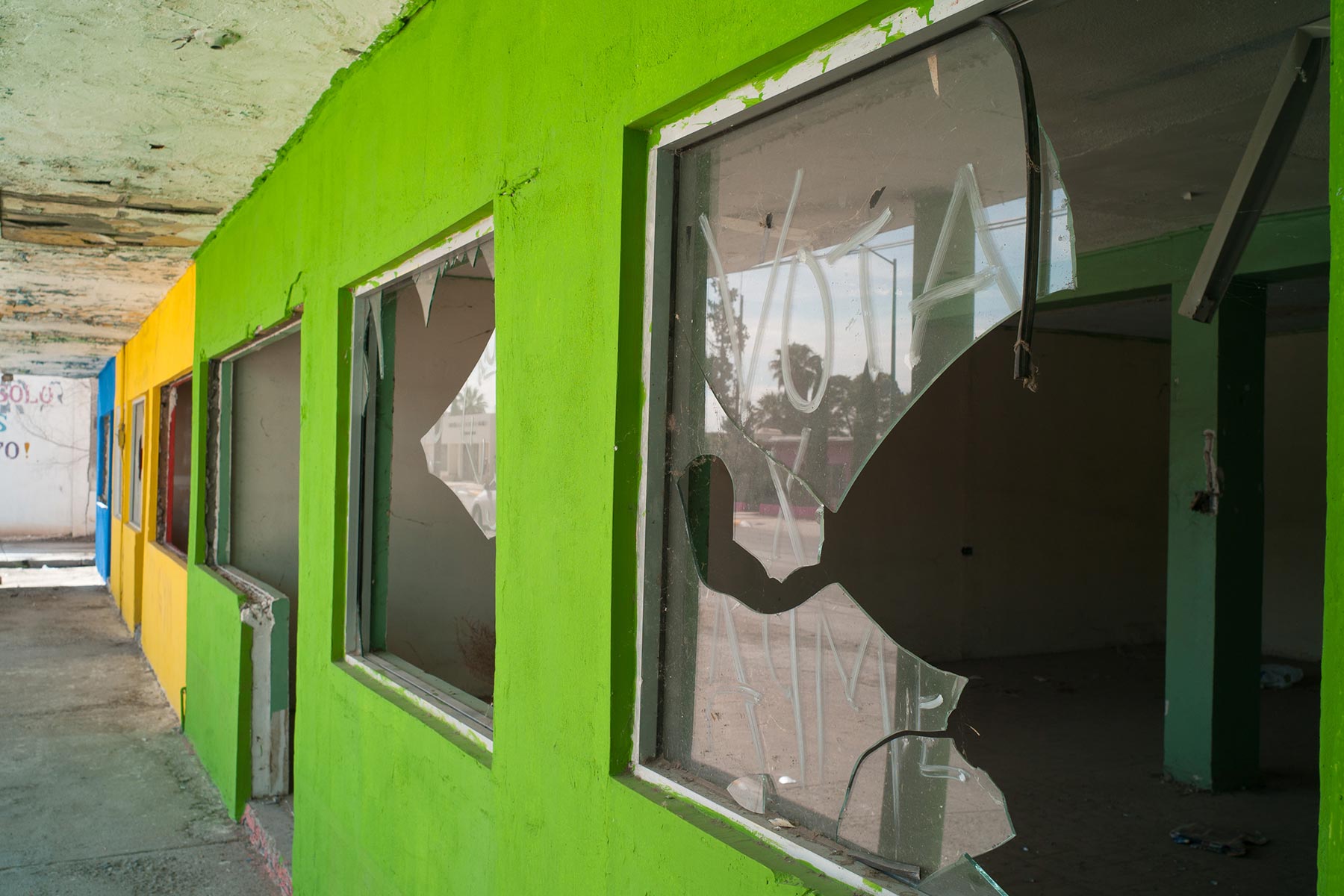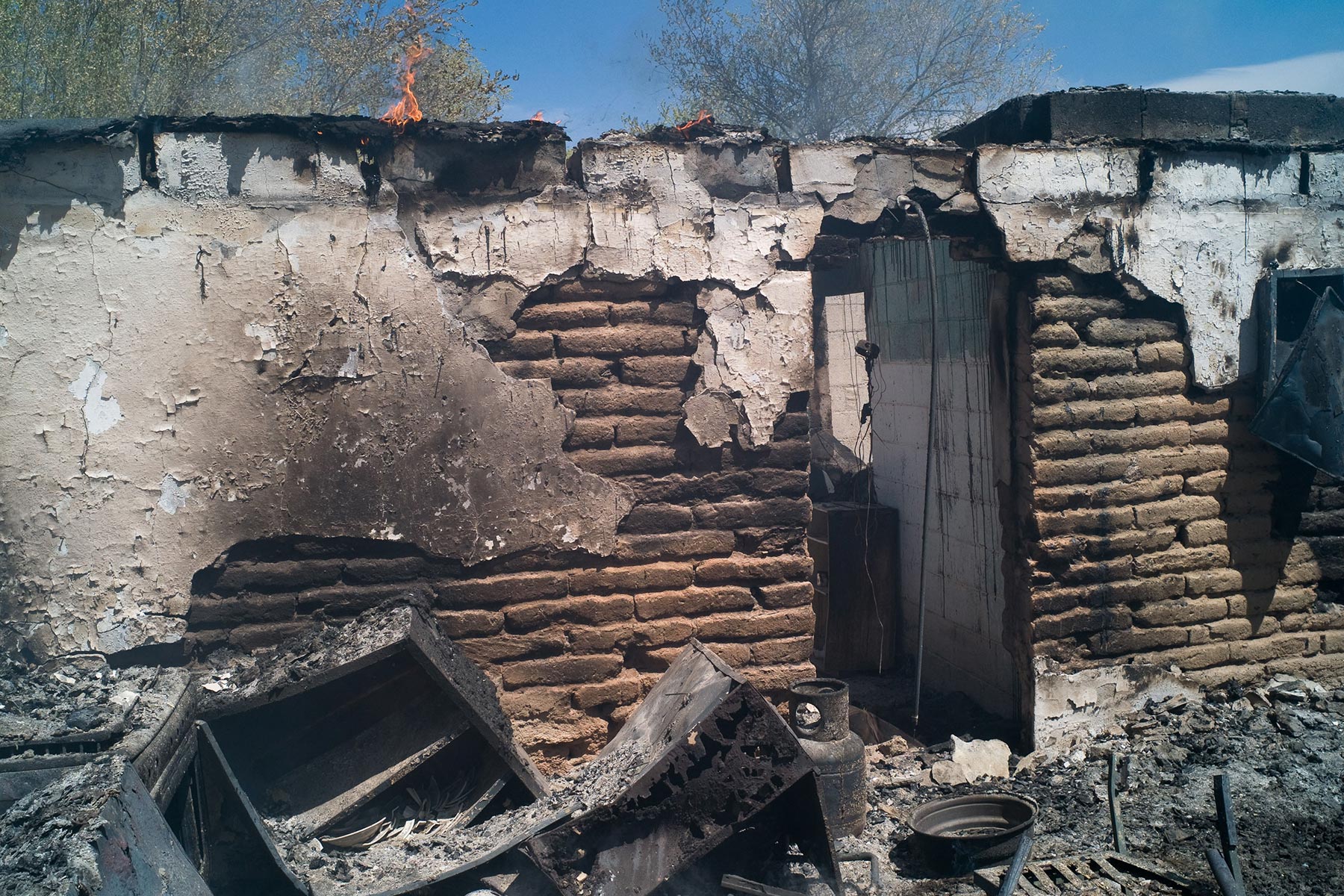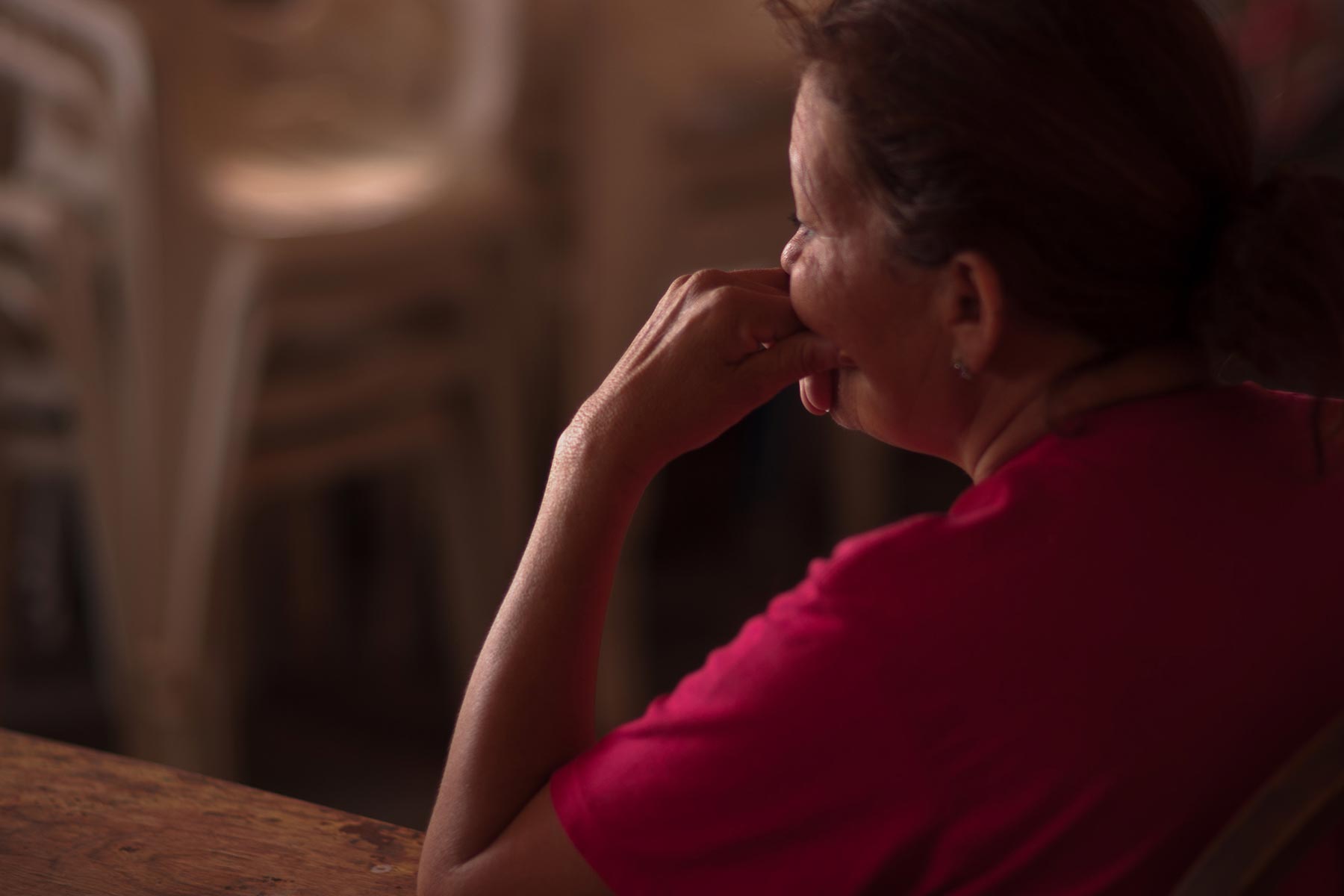
Mexico's ghost towns
Residents seeking asylum in US fear returning to deadly Juárez Valley
In the spring, the mayor of Guadalupe had dozens of homes and businesses in the downtown area painted in vibrant shades of pink, blue, green, orange and fuchsia. They are buildings that have been abandoned by their owners or burned remains after being torched by the owners’ executioners. Each dwelling is an insult; instead of portraying life, the fresh coats of paint give testimony to barbarity and impunity. It is the face of a cadaver dressed up with vulgarity.
Guadalupe is one of a handful of towns in the 55-mile Juárez Valley, along the Rio Grande. The region was a hub of cotton production in its heyday. But these days, Guadalupe is a ghost town, inhabited mostly by older residents who refused to leave their homes or poor ones who were unable to. In a town whose population was 10,000, authorities have reported more than 300 killed since 2008. Among the victims are mayors, former mayors, police chiefs and patrolmen, councilmen, businessmen, politicians and social activists. Many of those who weren’t killed fled.
Martín Huéramo is one of them.
Huéramo, 48, served as one of six members of the Guadalupe City Council. He and hundreds of other Juárez Valley inhabitants have found refuge in Fabens, Texas, while the United States decides if they should be granted political asylum, which is rarely given to Mexicans. They are all convinced that the terror in their hometown has nothing to do with a supposed turf war among drug cartels, as the government and mainstream media attest.
Instead, they believe, the massive violence was provoked by the government itself, at the behest of a handful of powerful investors. In the abandoned and burned-out remains of Guadalupe, former residents see a scorched-earth policy: The state colluded with capitalists and criminals, they say, to empty the area of both residents and industry so that large binational groups could swoop in and develop huge infrastructure projects on valuable borderlands rich in natural resources.
“Ever since the first violent event, in which federal agents opened fire on two innocent teens, the authorities have been involved in all the bloodshed I have known about,” Huéramo said, sitting in front of an old mobile home on a desert plain in Fabens.
The first violent event Huéramo recalls happened on March 4, 2008.
On that afternoon, two young men traveling in a car with no license plates evaded a federal police checkpoint in the town of San Agustín, allegedly because they feared their vehicle would be seized. According to witnesses, the police officers opened fire on the young men without first trying to persuade them to stop.
The passenger, Héctor Carrillo Soto, 21, bled to death minutes after being shot in the back, near the heart. The driver, Urbano Jiménez, Carrillo’s cousin, was beaten by officers.
The agents’ excessive use of force sparked an uprising from the townspeople. They built barricades with furniture and set them on fire to stop the agents from fleeing. Tensions started to calm hours later after it was announced that the federal police would leave the valley.
A few days later, hundreds of soldiers were sent to replace the federal agents. It was part of the Chihuahua Joint Operation, the name given to then-President Felipe Calderón’s war on drugs. Instead of bringing peace, the new system turned the Juárez Valley into the region with the highest rate of homicides, kidnappings, extortions and exoduses in the state.
‘Authorized crimes’
Huéramo and his family crossed the U.S.-Mexico border on Feb. 22, 2011. The day before, somebody called his cellphone and told him that if he didn’t leave in 24 hours, he would be the next councilman assassinated. On Feb. 16 and 19, two women on the council were killed. One of them was shot in the mouth while she was in the small grocery store she owned, and the other was killed in her car after leaving her office.
The year before, two of his brothers-in-law and a nephew were also murdered. Huéramo said he cannot claim that the killers were military but tells of a disturbing trend.
“From the information we got, we could see that in all the cases where somebody disappeared or was killed, the military was always there before and searched the victims’ homes,” he said. “In some cases, the killers got there 15 minutes after the military and killed the people. In other cases, the killings occurred two hours or even a week later. All the people who were killed always had previous contact with the military, which first searched their homes and saw they were unarmed. There were no confrontations in the Juárez Valley. They were all killed in cold blood.”
That is what happened to his relatives — Carlos Perea (a legal U.S. resident and an employee at an international port of entry), Martín Perea and César Perea, 15.
Martín Perea was driving a mint condition double-cab pickup truck. He told his family how soldiers at the military checkpoint on the way to Carlos Perea’s house in San Isidro more than once tried to confiscate his vehicle.
On June 27, 2010, after another squabble with checkpoint soldiers, a group of men wearing black military fatigues and masks opened fire on the three as they arrived at Carlos Perea’s home. Martín Perea was sprayed with 50 assault rifle bullets. Carlos Perea was shot in the head. César Perea, who ran toward the house, was shot in the back. The police never investigated the military.
“[The military] are the highest authority, so what else can you do? Flee the country, because you won’t be safe in any other part of Mexico,” said Huéramo.
In Fabens, Huéramo found a legion of other refugees, including neighbors and acquaintances from the valley. Many more came from Juárez and Villa Ahumada, a town 60 miles south, where the most important deposits of silver in the country were recently found and there are plans to install the largest concentration of solar plants in the country.
Carlos Spector, an American lawyer in El Paso, Texas, is handling the cases of 250 families — about 200 of them from Guadalupe — requesting political asylum in the U.S.
“The conclusion I have drawn from all of this is that most of the cases are authorized crimes,” he said, stretching his arms above the dozens of files spread out across his desk. He has doubts whether organized crime groups ever operated in the valley independently of the state. “However, from the American perspective, it is a lot more convenient to think and say that it is a case of Batman and Robin versus the Penguin [or] Superman and the bad guys, day and night.”
Scorched earth strategy
Guadalupe was once the vibrant center of a proud agricultural region. Decades ago, the valley’s cotton production rivaled Egypt’s. The prosperity resulted in the creation of towns such as El Porvenir, an eastern town that would become the second-largest settlement in the region.
In the early 1970s that dynamism hit its first setback when the federal government built a canal to drain sewage from Ciudad Juárez. It runs parallel to the Rio Grande and waters the region’s parcels, which are gradually getting smaller and more arid. The problem is that the canal dragged not only the city’s sludge but also thousands of cubic liters of toxic waste produced by the maquilas, or industrial plants. According to those who left the valley, that was the real goal of the canal’s construction.
The result: The quality and international sales of the region’s cotton sank, and the agricultural potential of the valley dwindled. Gradually the cotton-processing plants disappeared, and the farmworkers and their children turned into factory workers, migrated to the U.S. or entered the emerging industry, drug trafficking.
“What happened in the valley is a phenomenon that has occurred in other parts of the world, something known as scorched earth policy. It comes from the desire for total control of the territory that first allowed to do away with the zone’s productive activity and then promoted its ruin,” said Victor Quintana, a researcher at Universidad Autónoma de Ciudad Juárez who has fought for the rights of agricultural workers in the region since the 1970s. “What happened was a combination of violence with capitalist interests to achieve this scorched earth, where you have no fertility or agricultural production and almost no population.”

For four years, starting in the spring of 2008, the valley was like a mousetrap for any citizen or criminal that passed through it. Federal Highway 2, which connects the area to the rest of the country, ends in the town of El Porvenir. What lies ahead is a dirt road that connects with lost ranches in the vast desert, which lies over large deposits of gas and oil. The army established four checkpoints on Highway 2 to control who entered and exited the area, officially to combat organized crime, and patrolled towns and side roads. At the same time, a cell of young men from the valley unleashed terror — killing and kidnapping people and burning their homes.
From the beginning, residents identified Mauricio “El Papacho” Luna Aguilar as one of the most active killers during those years, along with Oscar Eduardo “El Negro” Vargas Romo and brothers Leonardo “El Toga” Rubén and Jesús Manuel “El Meño” Morales Rodríguez. All of them were born in Guadalupe or Caseta, a town bordering Fabens. They worked with Gabino “El Ingeniero” Salas.
Vargas and Luna were apprehended in the first months of this year, accused of killing, kidnapping and extorting at least 200 people from the zone. Salas was reportedly shot dead in a clash with Juárez policemen who supposedly invaded the valley illegally in August 2013. Rubén and Morales were also killed by police forces, in the state of Sonora, where they had fled with Vargas.
According to the government’s version, the men were members of the Sinaloa Federation, Mexico’s most influential drug cartel, headed by Joaquín “El Chapo” Guzmán, and were trying to wrest control of smuggling routes from the Juárez Cartel. But nobody from the Sinaloa organization has ever been seen in the area.
What is gleaned from testimony gathered through the years is that the men worked without ever being pursued by the military or federal police, even though some of their crimes were committed just a short distance from the military checkpoints or shortly after police had patrolled the area.
Seeking asylum
Carlos Spector is the son of an American father and Mexican mother. His relatives once lived in Guadalupe and Villa Ahumada. As a teen, he vacationed in those places, establishing ties with family and friends that he keeps strong today.
After the killing in January 2010 of Josefina Reyes Salazar, an activist from Guadalupe who tried to shed light on the abuses committed by the military and federal police, many of Spector’s old acquaintances got in touch with him. Soon they numbered in the hundreds.
Reyes’ death was the first of a series of attacks and threats against civil rights activists from the valley and Ciudad Juárez , but it was members of the Reyes family who received the worst of it. In the months after Josefina's murder, three of her brothers and a sister-in-law were killed or disappeared, and many other relatives later met the same fate. Those who survived fled to the U.S., seeking asylum.
“From the start I saw that it was an attack of the state on the civilians that could get in its way,” Spector said of the Reyes case. “Something the state will never forget or forgive is that you draw the connections between the state and crime itself, and that is what I call authorized crime.”
Since then, Spector has worked 10 to 15 cases a day, but he is only one of many immigration lawyers taking cases of Mexicans fleeing terror.
He encouraged the people from the valley, Villa Ahumada and Juárez to form Mexicans in Exile. The group now has 300 members; 98 percent of them come from Guadalupe. Fewer than 10 have been granted asylum, and the rest remain in limbo. But together they have sought psychotherapy, jobs and, above all, clarity about the source of their misfortune.
For Spector, what happened in the valley is “the emblematic case in the country to understand what is happening [in Mexico].”
“There you have all the government institutions colluded with crime. That is why we understand the families from Ayotzinapa, with whom we have met recently.” (In September 2014, 43 students at a teachers’ college in Ayotzinapa in the southern state of Guerrero were kidnapped and disappeared by local police and cartel members, allegedly on orders from the mayor of Iguala, a nearby town.)
Black gold
Even with 90 percent of the valley’s population gone, terror hasn’t ended there. The zone is now under control of state police officers and new members of a criminal cell who operate with impunity, according to Spector. Drug trafficking continues, but more than moving drugs, criminals steal cattle and agricultural machinery and, in doing so, stymie efforts to exploit good arable land.
“The purpose is to cause hopelessness,” said Quintana, who has researched violence in the valley. “All this does is give way to the activities the mafias are looking for, be they legal or illegal ones. In view of the upcoming fracking operations, the only types of businesses now allowed [by the government and criminals] are whorehouses and bars, [to have] a captive population for this kind of enterprise.”
In February 2014 the Mexican Institute of Petroleum brought forth evidence of the existence of natural gas and shale oil beneath an enormous strip stretching from east of Juárez to Tampico, in the state of Tamaulipas. Such resources are part of the Eagle-Ford Basin, which extends east across southern Texas.
The black gold brought together about a hundred regional businessmen to participate in a project, Chihuahua Energy, to explore and exploit the region’s shale gas reserves. In August the group raised the possibility of buying a shale gas well in Odessa, Texas, in order to learn the extraction processes they plan to use on the Mexican side of the border.
Birth of megaprojects
A vision for the future is what sets big businessmen apart from other mortals. Fifteen years ago, Andres Barreda, a member of the People’s Permanent Court in Mexico, had a meeting with agricultural activists from Chihuahua. There, he told them about the future of agricultural work in the Juárez Valley, informing them of proposals for the gas and petroleum reserves there.
“He seemed to have a crystal ball in his hands. All he said came true, almost completely,” said agrarian leader Martín Solís, the head of El Barzón Chihuahua, the most important agricultural and political organization in the state.
Solís said the government has no interest in investigating the murders or institutional corruption sparked by the agrarian conflict. Its focus is the promise of multimillion-dollar investments.
Since the beginning of the year, Chihuahua Gov. César Duarte has repeatedly told the press that Mexico’s structural reforms will be a boon for Chihuahua. Not only has he referred to the shale gas and petroleum reserves along the border, but he has also talked about great new highways and pipelines. There is a promising future in Villa Ahumada’s desert vastness, he has said, where a large amount of electricity will be generated by solar panels.
“Chihuahua is becoming a key state for the transportation of natural gas,” federal Energy Secretary Pedro Joaquín Coldwell wrote in the Juárez newspaper Norte in March 2015. “The Encino-Topolobampo pipeline is being built. It will start working in the first half of 2016. In the following months, work for the construction of pipelines in Waha–San Elizario, Waha-Presidio, Ojinaga–El Encino–La Laguna will begin, which will bring cheaper natural gas from the United States and will provide this type of fuel for the whole state. The Encino locality will be one of the main interconnection points to distribute it in the northeast and central part of the country.”
Mexican telecommunications mogul Carlos Slim’s Carso Energy Group won the bid for the Waha–San Elizario project, which extends from Odessa to El Paso, Texas, in late January. The pipeline will connect with the San Isidro–Samalayuca section, and the Waha-Presidio line will join with the Ojinaga–El Encino–La Laguna project, which is being built by TransCanada and will go through the Tarahumara Sierra all the way to Topolobampo, on the Gulf of California.
“Of course, the most uninhabited areas [because of violence] are exactly the same as those planned for the development of these megaprojects,” said Solís. “First, there was an emptying of the area by means of violence, which brought a depreciation in the value of ranches and great expanses of desert land, and now they can purchase these properties at very cheap prices because they are now abandoned.”
“That’s what terror is about,” he said.
The president of Mexicans in Exile, Alfredo Holguin, said that the group sees a lot of families come and go but that in the past four years its average hasn’t been less than 300.
“Not all exiles are with us, of course,” he said. “We estimate that there must be about 10,000 to 15,000 people hiding somewhere in the United States, hoping the threat will fade so they can return. I don’t know. In my case, as in the case of everybody at Mexicans in Exile, it is clear that our lives in our country were destroyed and we cannot return even if we want to.”
Life in exile
When the violence erupted in 2008, Hector Lozoya was the Juárez government representative in Zaragoza, a town at the western end of the Juárez Valley. As city official, he met farmers from Guadalupe, Villa Ahumada and Juárez who asked him to mediate in order to recover 5,000 acres that, according to them, were stolen by one of the most powerful families in the region, the Fuentes.
The Fuentes exercise control over a huge part of the distribution network of natural gas from the U.S. to Central America. Coincidentally, the lands taken from the farmers are the site of planned highways to connect to the new international crossing at Tornillo-Guadalupe. They are also rich in water deposits and are part of the region’s gas and petroleum basin.
“The link between the violence and private interests is clearly established,” said Lozoya, who now heads Juárez’s sanitation department. “They made people leave so they could take over their lands and homes. It is not by chance that criminals knew everything about them, be they locals or from out of town. They had all the information — access to public records that clearly established what each extorted person owned. How could a common criminal get such information? Only with help from the authorities.”
Some of the affected farmers had as their defender then–Guadalupe Mayor Jesús Lara Rodríguez. Lara was killed in June 2010 while arriving to his house in Juárez, where he sought refuge after abandoning his hometown. Before him, two of his police chiefs were assassinated, as were the two councilwomen who worked with Huéramo. Although Lara’s death was never related to the stolen lands, he had been a whistleblower about the terror.
Huéramo, who as a councilman in Guadalupe saw the plans for many of the projects in the Juárez Valley that form the fabric of the country’s energy future, said he needs no more evidence than his life experience to prove that the supposed war between drug cartels in the valley — and the rest of the country — is fabricated.
In 1968 he escaped from being shot to death because he was only 1 year old. At the time, he lived in his grandmother’s ranch in Chupícuaro, in the state of Michoacán. Soldiers killed his grandmother with 19 shots. Years later, his father told him she was assassinated because she refused to sell her land.
“Some time later, poppy and marijuana were planted there,” Huéramo said while sitting in front of his mobile home in San Elizario, Texas. “What’s clear to me is that I have not only experienced violence from 2008 to this day. I have lived with violence since I was born. And we were exiled, not in our own country but in another, on this side of the border.”
Translated from Spanish by Julián Cardona
